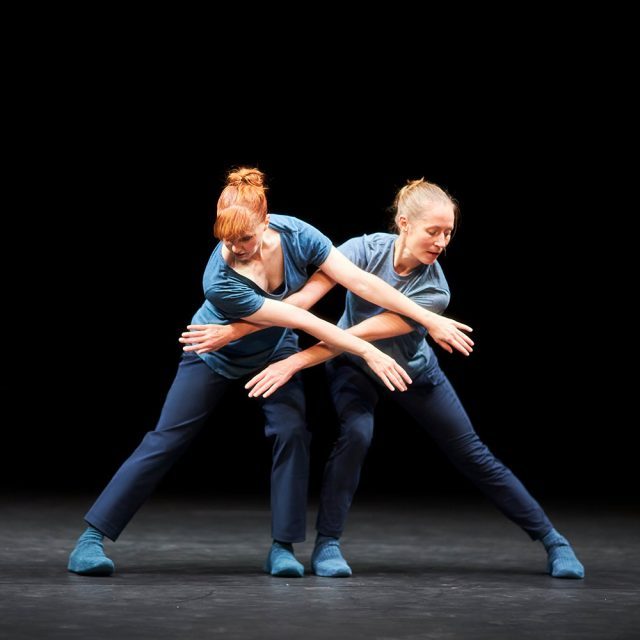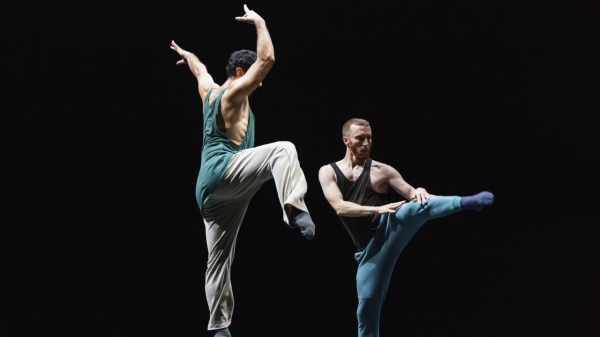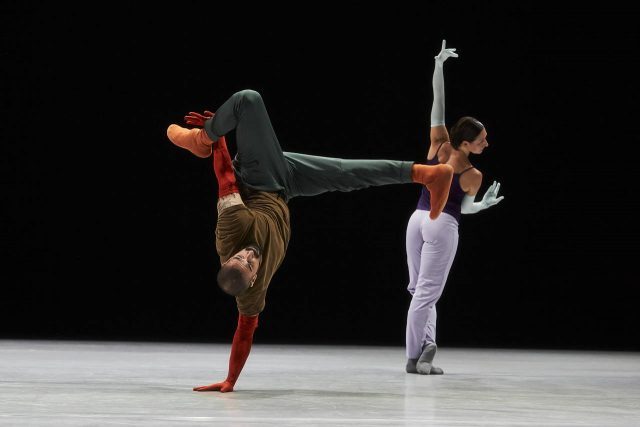
Jill Johnson and Brit Rodemund in William Forsythe’s A Quiet Evening of Dance (photo © Mohamed Sadek / courtesy the Shed)
The Shed
The Griffin Theater in the Bloomberg Building
545 West 30th St. at Eleventh Ave.
Through October 25, $42-$92
646-455-3494
theshed.org
In May 2018, William Forsythe presented a site-specific work as part of “A Prelude to the Shed,” a preview of what New Yorkers could expect from the new arts center at Hudson Yards. The free collaboration, Tino Sehgal: This variation and William Forsythe: Pas de Deux Cent Douze, put visitors right in the middle of the action as near-total darkness evolved into a cappella singing and an energetic duet as the walls of a temporary facility opened to the street. Choreographer and visual artist Forsythe, the former head of Ballet Frankfurt who has worked independently after ending the Forsythe Company in 2015, is back at Hudson Yards with A Quiet Evening of Dance, a lovely evening-length piece continuing through October 25 at the Shed’s Griffin Theater. Consisting of new and reimagined repertory works, the hundred-minute performance is divided into two main sections, taking place on an empty stage at floor level, putting the ten dancers on equal footing with the audience.

William Forsythe’s A Quiet Evening of Dance focuses primarily but not exclusively on a series of duets (photo © Mohamed Sadek / courtesy the Shed)
The first half consists of four parts, focusing primarily on duets that are almost like a primer for Forsythe’s choreographic language, which relies heavily on the deconstruction of classical ballet, emphasizing the movement of the arms and hands and upper body. “Prologue,” featuring Parvaneh Scharafali and Ander Zabala, and “Catalogue,” with Jill Johnson and Brit Rodemund, are set in near silence, the only sounds coming from bird tweeting and the dancers’ breathing — some breathe significantly harder than others, like different sounds that emerge from tennis players in the midst of a match, though not as forceful and urgent — and their feet, which glide across the black floor in sneakers covered in wooly socks whose colors sometimes are similar to the wrist-to-biceps gloves they wear that give yet more weight to their arm movement. (The playful costumes are by Dorothee Merg.) Johnson and Rodemund’s duet also has them exploring their entire bodies in a thrilling kind of anatomy lesson. “Epilogue” follows, a series of duets in which Scharafali, Zabala, Johnson, Rodemund, Brigel Gjoka, Riley Watts, Rauf “RubberLegz” Yasit, Jake Tribus, and Roderick George (whom I saw perform a sizzling solo last year when his Pas de Deux Cent Douze partner was unable to dance with him) rotate onstage to Morton Feldman’s soft “Nature Pieces from Piano No. 1,” each dancer establishing their unique personalities: Scharafali with her casual elegance (with her hands at times in her pockets), Johnson with her stoic presence, Watts with his emotional facial gestures, Yasit with his body-twisting (though repetitive) contortions. Gjoka and Watts, moving in rare unison, conclude with “Dialogue (DUO2015)” before intermission.

Rauf “RubberLegz” Yasit and Parvaneh Scharafali in A Quiet Evening of Dance (photo © Mohamed Sadek / courtesy the Shed)
A co-commission with Sadler’s Wells, where it debuted in October 2018, A Quiet Evening of Dance continues after intermission with “Seventeen / Twenty One,” which is not quite as quiet though just as winning as the dancers, now on a white floor, use the language they explored earlier in a more complexly structured work, set to Jean-Phillippe Rameau’s Baroque “Hippolyte et Aricle: Ritrounelle” from Une Symphonie Imaginaire. The title links the seventeenth and twenty-first centuries — Rameau was born in 1683 — as all ten dancers whirl about the stage, ranging from solos to duets to trios and then everyone coming together for a grand finale.